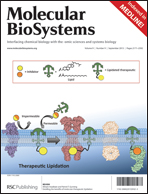Polyethyleneglycol crosslinked N-(2-hydroxyethyl)-polyethylenimine nanoparticles as efficient non-viral vectors for DNA and siRNA delivery in vitro and in vivo†
Abstract
A series of electrostatically crosslinked nanoparticles, N-(2-hydroxyethyl)-polyethylenimine-PEG600 (HePP), was prepared by allowing N-(2-hydroxyethyl)-polyethylenimine (HeP) to interact with polyethyleneglycol (600) dicarboxylic acid (HOOC-PEG600-COOH, PEG600dc), they were then evaluated for their capability to transfect cells in vitro and in vivo. DLS studies revealed the size of the HePP nanoparticles in the range 106–170 nm, which efficiently condensed nucleic acids and provided sufficient protection against nuclease degradation. HePP–pDNA complexes exhibited a considerably higher transfection efficiency and cell viability in various mammalian cell lines, with HePP-3–pDNA displaying the highest gene expression, which outperformed HeP and the commercially available transfection reagent, Lipofectamine™. Also, HePP-3 mediated sequential delivery of GFP specific siRNA resulted in ∼76% suppression of the target gene. Intravenous administration of HePP-3–pDNA complex to mice, followed by monitoring of the reporter gene analysis post 7d, revealed the highest gene expression occurred in the spleen. Together, these results advocate the potential of HePP nanoparticles as efficient vectors for gene delivery in vitro and in vivo.


 Please wait while we load your content...
Please wait while we load your content...